
LOS KENYA
LOS KENYA VOL 2 (Vampisoul VAMPI 309)
Munster Records have continued to bring us the finest salsa and boogaloo Venezuela has to offer. And back at you again, comes the great Ray Pérez, pianist and arranger, with his band Los Kenya and Volume 2 of their works. In the late 60s he also fronted Los Dementes and Los Calvos as he was experimenting with different line-ups to create sounds he wanted. But Los Kenya were not a studio band like the other two: they had gigs and their popularity led to six albums released between 1968 and 1972. Despite the title, this was actually their third album and has a lot of breadth and depth in its ten tracks. The key sound is salsa dura, or hard salsa, with hard-hitting congas and bongos behind the piano and brass, there is also kit drums and bass. Overall there's a great "live" feeling to the tunes as if they were recorded in a long jam session after a particularly good gig. Singers are Carlín Rodríguez (a guaracha and bolero singer who also performed with the other Pérez groups), Dimas Pedroza, and Ray himself on two numbers. Your 50-year old copy might fetch 184 euros on discogs; on the other hand you can get a mint copy now and make up for lost time.
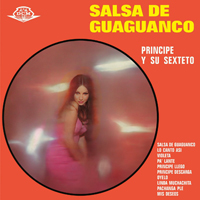
PRINCIPE Y SU SEXTETO
SALSA DE GUAGUANCO (Vampisoul VAMPI 292 LP)
Here is a musical hybrid from 1967: a Venezuelan band playing salsa but adding in a tropical lead guitar which gives it a strong flavor of electro-cumbia. Once again the good souls at Vampisoul have found a great debut album by an obscure band and also the original tapes, which have been remastered. Though essentially salsa with guaguanco and pachanga rhythms, there is a rock n roll sensibility to the presentation. The band are superb: the guitarist enjoying the limelight but the rhythm section are right there fromt and center, and you can tell, from the vocalist and chorus, they are enjoying themselves immensely during the recording. Restoring the tapes from Discomodo, turned up three more selections which had never been issued, and those are bonus tracks thrown in to stretch out the fun. There's a lot of stop-start as they throw it back and forth between various rhythms, toyed with and tossed about between the bass and percussion. It's almost like they are trying to catch out the guitar player, who goes from simple chording to a charanga violin part to full-on blazing rock. But on tracks like "Todo se acabo (It's all over)" they take a gentler approach and the subtleties of the instrumentation come to the fore.
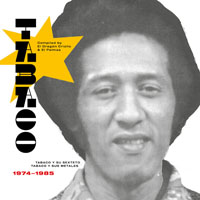
TABACO
1975-85 (El Palmas Music)
Once again El Dragón Criollo has been crate-digging in Caracas and come up with the latest collection of danceable hits from yesteryear. A child of the streets, hustling and shining shoes, Tabaco (so-called because he was long and thin like a cigarette) would listen to bands rehearsing and ended up joining Sexteto Juventud. He tried out playing every part until he ended up as vocalist. The other band-members liked his charisma and the fact he sounded a bit like Ismael Rivera, top Puerto Rican vocalist then active in New York, with hits on Tico. At 20 Tabaco created his own sextet which morphed into Tabaco y su Metales, with the metals being his own percussion playing on cowbell, as evidenced in the rip-it-up "Arrollando." There's also great bongo playing on this track. It's clear his hero was Beny More, from his writing and delivery. He also performed in prisons to show those unfortunates they weren't forgotten. But due to his harsh upbringing he was in poor health and died young, leaving a gap in the world of his many fans. "El Tren de Porky" has the immediacy of a live jam, with percussion high in the mix, hot horns and a scorching tres. In "La Libertad" he pays tribute to Beny and Celia Cruz and others who had defined the music. This compilation draws from his two bands' output, mixing his lyrics dealing with social injustice and the strong African rhythms he brought to salsa Venezolano.
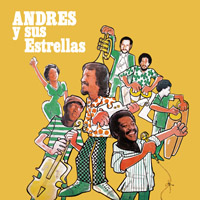
ANDRES Y SUS ESTRELLAS (El Palmas Music LAD30014)
Yes, the rediscovered musical land of Venezuela continues to yield its treasures. Little is known however of this group fronted by guitarist Andrés Moros a.k.a. Morito. There is a vocalist named Nano Grant and a lady singer on the ballads, only called Yira. They recorded a very hot set of music in 1976 when Caracas was going through a salsa boom. In those oil-enriched years Caracas hosted many Latin acts which were boomed out to the Western hemisphere on Venevision. (I remember one variety show on Saturday nights which was as big as Don Francisco and Sabado Gigante.) Moros would encounter Grant in bars and small clubs, playing with different bands, and long held out the hope they could record together. This disc was the result of that encounter. It builds in intensity with two of the hottest numbers, "La Mazucamba" and "Linda Caraqueña," closing out the set. Merengues and boleros fill out the repertoire. On the upbeat numbers Morito's electric guitar sounds like a tres. There's tasty horns, a piano and bongos; the whole album is as danceable now as it was half a century ago.
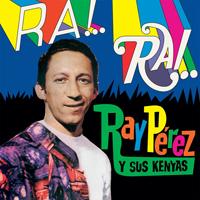
RAY PEREZ Y SUS KENYAS
RA!.. RA!.. (Vampisoul VAMPI 277)
First issued in 1969, this was the fourth and final album of Los Kenya, blockbuster Venezuela musical pioneers. Perez was a very busy pianist, hopping between Los Dementes and Los Calvos, so it's hard to know which band he was in when. But this meant he was always looking for new ideas to try out in different configurations. This time it's 1960s California pop-rock, with calypso, soul and jazz, all added to the salsa/sauce, which he based on the solid foundation of Eddie Palmieri and Ricardo Rey, two of his musical heroes. There is salsa dura on here and son montuno, but he is primarily experimenting, and "Uvas Verdes (Green grapes)" sounds like a mix of Burt Bacharach with Samba vocals over a complex bongo beat. The components don't work together, for me. Similarly the chorus and weird rhythm of "Linda cancion (Lovely song)" don't stand the test of time, but the band is on better footing with "San Juan Guaricongo" by Estelio Cabrujas and "Pilar" which have a bomba feeling. Tito Ochoa sings lead on "Como me voy a reir (How I'm gonna laugh)" and I prefer his vocals to Larry Francia. He seems to be the salsa singer, and those cuts are preferable to my ears. The twin trumpets also work out on those, especially on the standout track "Mi sonsito." This is not the same as Eddie Palmieri's "Mi sonsito," though obviously that is one band Perez is emulating. I like the salsa tracks, otherwise the trumpets are doing Herb Alpert-like toots which overwhelm the singer.
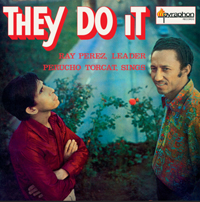
RAY PEREZ
THEY DO IT (VampiSoul 275)
There's no stopping Ray Pérez, Venezuelan salsa singer, pianist and bandleader. As we have recently learned, with the gradual reappearance of his back catalogue, he created a fun jam band called Los Dementes in 1965, then Los Kenya (1968), and then he formed Los Calvos, the "Baldies," before moving to the Big Apple in the late 60s. Inspired, he returned to Venezuela in 1971 and picked up where he left off. For me it's a like a chunk of legendary salsa band La Perfecta suddenly popped up. It is that sweet and rare a treat. This 1971 album came out under his own name, with singer Perucho Torcat (from Los Dementes). It's salsa duro, which means watch out for trombones. There's some silly scat singing but mainly driving danceable salsa. They mix it up with a bolero and some boogaloo. There is a sound problem with the first track on side B, which I wished they had addressed. It sounds like it was recorded in a tin can, at least for the opening few bars: they must have been experimenting in the studio with some filter on the board: big mistake, but don't let that deter you. This one goes on repeat. There's lots of stop-start breaks to tease dancers too, as on the guaguanco "Lo que el abuelo cantaba (What grandpa sang)." The title suggests it's an old song, but my Spanish is not good enough to follow, however the twin trombones blast hot air over cowbell and timbales and Pérez vamping madly on the keyboard. The riffs are great, like a lexicon of salsa with horn counterpoint driving the singer closer to the mike. When they bring it down the piano hangs in the air between ideas, and we hear the conguero and guiro, with the timbales player just ticking the time on the sides of his kit. "Muchacho loco (Crazy kid)" is in English but that still doesn't mean I know what he is singing about. There's a Ray Charles "Ain't that Peculiar"-sort of riff on the pianist's left hand, to set it off, but then everyone throws down with a fiendish heat that suggests they rehearsed to the point where Pérez could point at the horns and they would know when to drop in a fat chord.
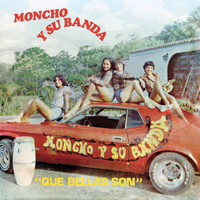
MONCHO Y SU BANDA
QUE BELLAS SON (El Palmas)
I have to admit, being an old crank, I got quite irritated with this label. They have been teasing the album for 4 months now, releasing advance singles from it and asking me to review it before I have heard it. "From the cover it looks like Peruvian cumbia," said Ken, our Washington, DC, correspondent. From the cover it could be low-rider music, or anything in fact. It's salsa, merengue, and also cumbia (the title cut), from Venezuela, where Las Palmas have been crate-digging lately. Moncho was a band formed by Ramón Urbina and they recorded this, their only album, in 1981. The label pressed only 500 copies and it vanished into the night. "Las 12" the stand-out track is a cover of a Beny More tune from the 40s, a mambo-bolero that builds on a piano vamp to a blasting horn line when the lovelorn guy hears his girlfriend return home (—"it's midnight and I can sleep happily"). There are two other exceptional tracks on here, which have already appeared as singles too: "Buscando una flor," a poppy guiro-driven cumbia which also features twin trombones, and "La Envidia," which sounds like a bomba, but is doubtless another cumbia, with heavy bass rumbling on the piano and more happy horns. I got over my pique, and really dig this album.
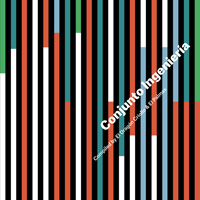
CONJUNTO INGENIERIA (El Palmas)
El Palmas have been diligently reissuing some exciting discoveries from Venezuela (now that that country's economy is in the tank & therefore, presumably, licensing is dirt cheap). With their man Dragón Criollo they have compiled some tracks from a tropical band formed at the Universidad Central in Caracas — surprisingly not from the music school but from the engineering faculty, hence their name Conjunto Ingeniería (The Engineering Group). They started out at teenage birthday parties but soon were spearheading the salsa movement in Venezuela, appearing on TV, and even backing la Reina, Celia Cruz, when she came to town. They had a secret weapon: one of their classmates regularly went to New York and brought back the latest releases from Tito Puente, Pete Rodriguez or Machito, which they devoured. They issued three albums in the sixties, moving from rock to Latin with ease. These have been sampled for this LP reissue (in a pressing of only 100 copies) which El Palmas have been teasing for a couple of months. It is interesting historically but musically it is a mixed bag. It opens strong with "Mambo Silbado," featuring a whistling chorus, then goes into a full-tilt salsa jam on "El Alacrán," that would do credit to any of those New York big bands mentioned above. Next up, "Amorcito" is a cover of the Diamonds' "Little Darlin'." They cover "Pare Cochero" by Orquesta Aragón as "Mambo Sancocho"; the horns are punchy but the xylophone is not a good addition (in my opinion). Similarly "Mambo rock" is a pretty weak and forgettable 12-bar boogie (based on "Mambo Italiano"), with a good trumpet solo. But these are all three-minute cuts; the album ends very strongly with "Aefo" and "Intermission riff." The former an original composition with a deadly boogaloo groove and some "Peter Gunn" horn blasts. The latter a Stan Kenton cover from the swing era, showing the wide range of their influences. This one has a fine trombone solo over a choppy tropical groove.
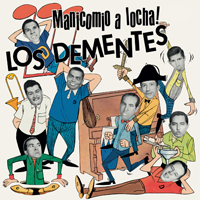
LOS DEMENTES
MANICOMIO A LOCHO (Vampisoul VAMPI269)
Covering many fronts, Vampisoul has been reissuing the works of bandleader and pianist Ray Pérez, one of the massive talents to come out of Venezuela. Los Dementes – The Crazies – found asylum at the Velvet label for their first recording. Like the great salsa bands of New York in the 60s the frontman is a trombonist. No personnel is listed but we hear guaguancos, a guajira and a mozambique in this hot selection of ten tracks. They made seven albums all together. Pérez went to New York and on his return created Los Calvos and Los Kenya and we have recently been gifted their fine albums on El Palmas Music (with El Grupo Casabe, reviewed last [& next!] month) and Olindo Records (with Los Kenya, reviewed in July). Seems like when it rains it pours because these labels are falling over one another in a rush to get Pérez's back-catalogue back in print – and with good reason. His band is tight and fiery and reminds me of Eddie Palmieri's La Perfecta which only made two albums (for Alegre in 1962 and 3) but had a huge impact, and the beefy trombone attack is familiar from Willie Colón. By 1976 Fania was issuing Los Dementes' music but the earlier seven albums on Velvet remained obscure (a copy of this one is listed at $150 on discogs). Singer Perucho Torcat has a good voice, though not in the league of Hector Lavoie, but I rate Pérez highly as a pianist and arranger. The title cut is a straight-ahead jam, you even hear a quote from "el Manisero" as the soloists find their metre. Other poppy riffs crop up here and there, such as the chords of "Guajira con Boogaloo," a straight-ahead 1-4-5 inviting you to jump in. In "Puerto Libre" we are blasting ahead when things stall abruptly and a lyrical trombone solo appears, quite magically. Throughout, terse but clever piano riffs grace the proceedings as quite often the keyboard leads everyone to a bridge and then a descarga. From this album you can see what the fuss is about: Pérez is a top notch bandleader and the whole group turns on a dime, delivering crisp solos with controlled yet explosive percussion challenging the vocalists for dominance.
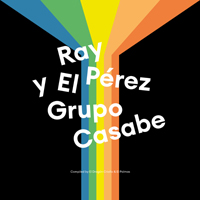
RAY PEREZ Y EL GRUPO CASABE (El Palmas Music)
From nowhere we have witnessed the emergence of Venezuelan bandleader Ray Perez. El Palmas continues to uncover his catalogue with this September 2022 release of a compilation of his 1970s work as a leading salsero. This is stately, confidently assured Latin music of the highest order. Perez has arranged vocals and horn charts in counterpoint, with a montuno piano to hold it all together. We now know, from recent releases, he was the force behind Los Dementes and Los Kenya and then had a brief round with two albums from Los Calvos, a reimagining of the earlier bands. This anthology was assembled by El Dragón Criollo & DJ El Palmas who were behind a fine series of Venezuelan reissues called Color de Tropico, also on the El Palmas label. Perez is a bandleader and pianist in the Palmieri mode, and of course when he went to New York in the late 60s he would have heard Eddie Palmieri's La Perfecta at their height. It's amazing that has stayed unknown as there are so many classic tracks on here; one presumes they had no international distribution. If he had stayed in NYC he would have ended up as a prominent musical figure. Casabe was his last major band, active from 1974-5. The fact he led so many successful outfits is due to label-hopping: he had to change band names for contractual reasons, so El Casabe was created when he moved to CBS. He brought along the drum kit, which was an unusual combination with traditional percussion in salsa, but now he relented and added saxes alongside the trumpets and trombones of his previous bands. And the new vocalist is the brother of El Negro Calaven from Los Calvos, Rodrigo Perdomo. But the main attraction is still his driving piano and the way the group waits, sitting back on the percussion, to pounce before slinging a load of molten brass into the mix. The album starts in medias res with a full-on driving groove, bouncing the different parts of the band, massed horns against vocal chorus, piano against guiro and tumba. The arrangements are superb: and it's not just salsa (a mix of mambo, cha cha, rumba, guaguanco, etc) because there are elements of rock (notably in the bass lines), boogaloo and son, in fact everything from a smoldering danzón ("La Reina") to surf music! Some tracks, like "Maria Antonia" are dynamite, waiting while the piano sits back on a I-IV vamp and hums along until the whole thing erupts volcanically. And it doesn't let up, but breaks into "Galeron con Maype" which might as well be called "Hell for Leather" as it tears off in a gallop. "El Bonche se formo" is another slow burner which just keeps smoldering teasingly for 4 minutes. "Adiós Bogota" send us off steaming. This is a great band and a great sequence of their best tracks, sadly the remaster was done from thrashed discs and so the sound quality leaves much to be desired. Ah well, twas ever thus!
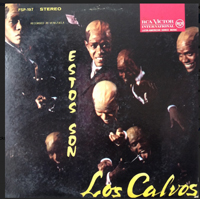
LOS CALVOS
ESTOS SON LOS CALVOS (El Palmas Music)
The opening track of this reissue is a boogaloo called "El Kenya," which was the name given to his subsequent band, by pianist and arranger Ray Perez. As I said in reviewing the second album by Los Calvos last month, Perez went to New York where he came under the spell of Fania's stars such as Eddie Palmieri. He returned to Venezuela where he formed Los Calvos, or the Baldies. We now have all three of his best albums coming out at the same time and more promised later this summer (so you don't have to spent $255 on discogs for a copy). This first album shows the weirdly constructed bald-wigged singer on the cover. There are a dozen two- to three-minute cuts on this album, all of them high energy salsa with the distinctive strong vocals of Carlos Yanez a.k.a. El Negrito Calaven (which i think means the little black baldie). The aim of the band was to allow space for soloists to stretch out and in addition to the regular guaguanco and pachanga of then-current salsa bands they even had a taste for surf rock, apparently, and the Twist. The drummer Frank "El Pavo" Hernandez said it was "like wearing a dinner suit with flip flops." The piano and vocals are the most notably improvising, the latter, Negrito scatting over Perez's montuno vamps. Los Calvos recorded two albums but did not perform live (relying on friends in the studio to cheer them on). However the next band, Los Kenya, was an attempt to create a pop group that could perform and they generated hits like "Bailemos Kenya (The Kenya twist)" with a view to performing. I assume there were contractual problems leading to all these convoluted arrangements. After a powerful propulsive set, they end with a ballad, "Te vieron con otro (They saw you with another)," which would do credit to Beny More. Everyone has a fine part: the piano, the swelling trumpets, even the bongocero makes a strong statement.
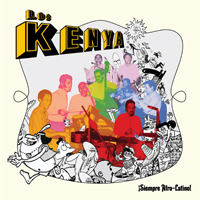
LOS KENYA
SIEMPRE AFRO LATINO (Olindo Records)
Los Kenya, like Wganda Kenya from neighboring Colombia, were inspired by African roots in their choice of name, but can be classed as a straightforward salsa band. "Soy el Negro Calaven," says the singer, introducing himself in the first song. Like their earlier manifestation, Los Calvos, it's top drawer stuff and the band must have torn up the dancefloor in its day, which was in 1968. The track "Record en TV" starts out like a boogaloo with a sustained vamp behind Carlin Rodriguez' vocals. I am trying to think of what it recalls: Hector Lavoe, I think. There's a piano break with bongos and the drummer Alfredo Naranjo playing an off-kilter shuffle, the the twin trumpeters return but it fades before it gets to a descarga where, one imagines, it would boil over. The trumpeters are Luis Arias and Luis Lewis (I wonder if they called him Louie Louie). It's an odd line-up with no sax or trombone, reminding me of African conjuntos of the same era, though in Africa they had many guitars instead of piano. But Venezuela is best known for harp music, or was until the excellent Color de Tropico series came out from El Palmas music. "Omelembe" has no writing credit; it was covered as "Chefo mae mae" by Kaba Mane who had a hit with it in Guinea-Bissau in 1986, but there was probably an earlier source. The last cut, "Descargan los timbales," begins with the two trumpets playing a trumpet voluntary straight out of the Baroque repertoire — quite a surprise — before they cut loose over some fiery percussion. At 5 minutes, it's the longest cut, but I would be glad to hear them stretch out for longer.
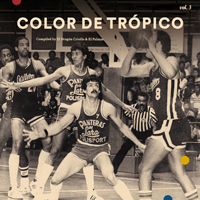
COLOR DE TROPICO VOL 3 (Elpalmasmusic.com)
We often hear about lost treasures uncovered by crate-diggers, but few of us get the chance to go digging for Venezuelan music of the 60s and 70s, so the notion of discovery is moot: it's all new to us outsiders. Here traditional Joropo music (a slow fandango-like dance) hits funk, rock and salsa head on. The digger in question is DJ El Palmas, based in Barcelona, abetted by El Dragón Criollo. So I imagine the Barcelona sound systems are as wild and active as those in say Mexico City, though I have not really experienced the nightlife in those cities, being more of a foodie and sightseer when I travel, though I always try to catch local live music. The tunes here are familiar. I have never heard Principe y su Sexteto before but his fabulous rootsy "San de Manique" is definitely a tune I know from a Cuban original. But before we get too comfy we are thrown a curve: The Pets' "El Entierro de un Hombre rico que Murio de Hambre (Burial of a rich man who died of hunger)," takes us straight to a carnivalesque Tommy James riff with a return of the Bach-like riffing we heard on the opener "Aquella Noche" by Un Dos Tres y Fuera. This time instead of a Bach fugue, the keyboard player lurches into "Dead March from Saul" before veering back to "Mony Mony," a decided Ray Manzarek or Rick Wakeman touch. Then psychedelic guitar knots up the outtro. "Shake it Baby" by Los Pájaros is bad boogaloo but we are too far into it to stop. "Toma Cinco," as the name implies, is a cover of Brubeck's "Take Five." Junior Squad give us a peppy cover of another forgettable pop ditty from the 60s, somewhere between Herman's Hermits and the Mamas & the Papas. It's hurting my brain to try to recall it. (Ah, it's The Turtles' "She'd Rather Be With Me.") We return to a more harmonious Latin groove for Johnny Sedes' lively "Guararé," a tune made famous by Los Van Van. And we go out with another unmemorable original (by Charles Aznavour) covered with extra twangy guitars and echo on vocals: "Tus 16 años" by Geminis 5. It's a weird set but might be fun at a party. For different reasons the tracks by The Pets and Principe are real gems and were worth finding.
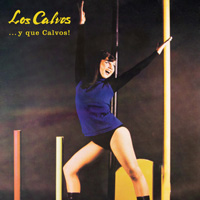
LOS CALVOS
...Y QUE CALVOS! (Elpalmasmusic)
Venezuela at the end of the 1960s was a hot-house of salsa and one of the top bands was Los Calvos (the Baldies), led by pianist Ray Perez. He waxed 7 LPs with Los Dementes (the Crazies) in 1967-8, then moved to New York, where he gigged with Kako's band briefly. On his return to Venezuela he formed Los Kenya, with two trumpets and a drummer, along with congas and bongos, which was unusual to say the least in the time of big bands. It was here he met vocalist "Calaven" who was to feature in his later group. Los Calvos were born out of Los Kenya, and each formation had a distinct sound. Over a powerhouse base of Afro-Caribbean rhythms laid down by drummer Frank "El Pavo" Hernández comes the gritty voice of Carlos Yanez "El Negrito Calaven." There's a big band power to the wind section to blow more steaming vapors over the dancers. The drums are an unusual touch, since most salsa bands featured congas and timbales and the pounding trap drums really create a powerful statement of rhythmic determination. These tracks are all in fact quite intense, and the vocalists get into the improvisation by scatting along when things heat up. "El moño de María (Maria's monkey)" was the hit off this, their second and sadly, final album. Lead singer "Calaven" also featured on a single from their first album, "Mi salsa llegó" from 1967, and El Palmas Music has reissued that single also, as a nice bonus item. Los Kenya are better known but not necessarily better; the rhythmic intensity of Los Calvos matches any salsa band of the era, from Eddie Palmieri to Ricardo Ray. From Perez's chops on the keyboards and arrangements I would say he is a close disciple of Eddie Palmieri and it's great to hear, for the first time, an absolute classic of salsa venezolano.
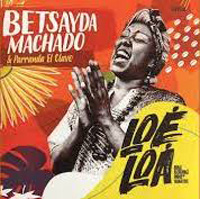
BETSAYDA MACHADO & PARRANDA EL CLAVO
LOE LOA (Sabroso)
Despite being restricted to rural villages in the bush in Venezuela, the Afro sound of Parranda has become known outside the jungle. Detour records celebrated the Parranda sounds of Garifuna music from Belize, Honduras and Guatemala, in 1993. From those sessions Aurelio Martinez emerged to some celebrity. Now we get to some seriously rootical sounds from this Afro-Venezuelan party. Subtitled (in tiny type) "Rural recordings under the mango tree," the album was produced by DJ Afro of Los Amigos Invisibles with Latin grammy winner Dario Penaloza. For this album they dispensed with other instruments (such as guitars) and concentrated on drumming and vocals. The musicians are descended from runaway slaves who set up communities called cumbes, in the bush, out of sight, and there they survived for generations, preserving their African traditions. The songs (in Spanish) are lovely, with strong lead vocals, chorus and shouts and powerful percussion, mainly hand drums with shakers. The group played weddings and funerals as well as other village social events at home for 30 years with no interest in recording or touring, they were simply keeping their music alive. But a video of them prompted an invitation to tour North America and that trip included Lincoln Center in New York. There are a "mere 8 players" of drums here, says Machado, compared to 100 or so that might show up to play for a Christmas celebration at home. "We are lucky to have the lano trees," she adds, "that make the best drums in our town." Now I have to trace whether "Louie Louie" comes from this tradition of the Loé Loá.
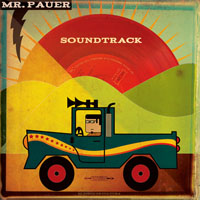
MR PAUER
SOUNDTRACK
A Venezuelan living and working as a DJ in Miami, Mr Pauer has absorbed influences from all over the New World to create a poppish electronica with a Latin tinge. As I remarked last month there seems to be a Kraftwerk revival going on among young DJs. While those creepily respectable Germans were influential in their day it seems unnecessary to revive their particular sound, though it does liven the drum 'n' bass monotony of a lot of contemporary DJ efforts. Mr Pauer seems much poppier than the folks he hangs with, like King Chango or Los Amigos Invisibles. The 7 3-minute ditties on this disc seem incomplete, like raw material waiting for a remix. "Que si que non" stands out, and comes closest to reminding me of Sidestepper, but it does seem like just the foundation for an as-yet unwritten song. When Kraftwerk sang, "We are showroom dummies," they were suggesting, ironically, that robots could be programmed to compose music. What they didn't realize was that soul-less machine made music put together from scraps and samples would come to be accepted as normal in the 21st century.
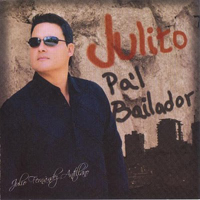
JULITO FERNANDEZ
PA'L BAILADOR (Salsaneo Records CD0824)
I have been lamenting that there's no good new Latin music coming out, or I seem to be missing it. Then I discovered this tasty gem from 2009 which IJ had borrowed and in a pang of guilt decided to return. It's classic salsa with big horn choruses (and it's not until halfway through that reggaeton beats intrude -- and only for a second.) Julito is the bassist on this set recorded in Caracas, Venezuela. Singers are Druber Salazar (who leads his own Yambo Band) and Glen Vasquez. In addition there are three other guest vocalists, a rapper, and three guys on backing vocals or coro. The showcase style of rotating singers works well. I don't recognise any names on here, which doesn't say much, as I am not up on the Caracas music scene, but one of the pianists is Julito's brother Fidel Antillano. Other band members have nicknames you only earn with years of expertise, like "Patatin," "Kiko," & "Caballo" on timbales (one at a time, most likely). However "Albondiga" on coro is doubtless more a dietary critique. Julito cites as his influences Soledad Bravo and Los Adolescentes; he has also accompanied many artists, including Tito Rojas, Cheo Feliciano, Oscar D'Leon, & El Canario. Many of the songs were written by Angel Flores, but the title cut by Julito himself really tears it up. Mandolin and cuatro appear on one track, "Cristal," but otherwise the outstanding solos are from trombonist David Gonzalez, Jr, saxophonist Oswaldo Lezema, and Jesus "Menudo" Moreno who plays piano on the title cut (which is played twice).